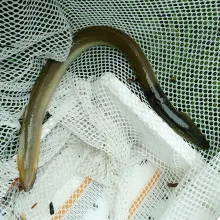Summer interns at the SUNY Oneonta Biological Field Station in Cooperstown stumbled upon a surprise recently when they caught a 12-inch American eel more than 440 miles from the ocean in a habitat from which the species was thought to have been extirpated.
The interns, high school graduates Alexa Platt and Lauren Saggese, were researching near the beginning of July in the Susquehanna River near the base of the Cooperstown Dam at Otsego Lake, NY, when they discovered the eel.
“I knew I would get exposed to a lot of things this summer, but I never thought this would be one of them,” Platt said.
Platt and Saggese are working to, respectively, characterize fish assemblages and invasive rusty crayfish densities prior to the planned stocking of juvenile eels in the watershed, according to their supervisor, Assistant Professor of Biology Daniel Stich. This is part of larger eel restoration efforts in the Upper Susquehanna River involving the state Department of Environmental Conservation, U.S. Fish and Wildlife Service, SUNY Cobleskill, Hartwick College and SUNY Oneonta.
American eels were reduced below detection during the late 20th century, which is largely attributed to construction of dams. This find represents the most-upstream record of the fish in the system in decades. Needless to say, it is generating much excitement among those enamored with the American eel.
From its origin at Otsego Lake in Cooperstown, the Susquehanna River flows for more than 440 miles, making it the longest river on America’s east coast. It eventually empties into the Chesapeake Bay in the state of Maryland. The location of the eel represents the very upstream extent to the Susquehanna River and is the terminal point to what historically was the longest fish migration on the East Coast.
